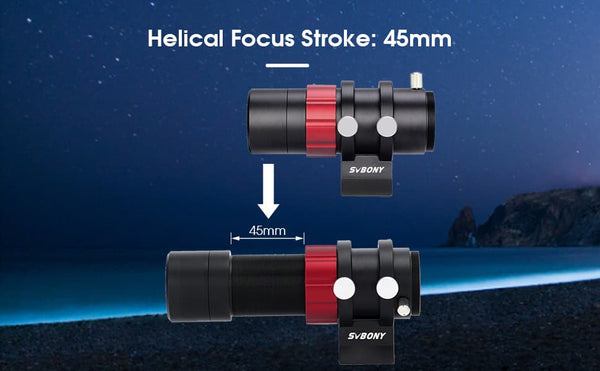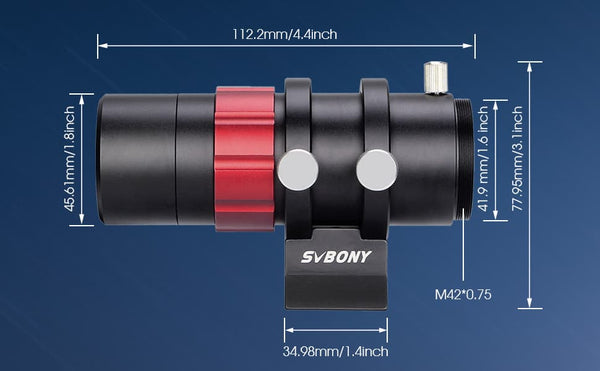Review: SVBony SV165 30mm f/4 Guide Scope
- jimmyastroaus
- Oct 5, 2024
- 5 min read
As we explored the SVBONY SV165 Mini Guide Scope, we found that it's a popular choice among both novice and some experienced astrophotographers. With its compact design and impressive optical performance, this guidescope has earned a favourable reputation in the astronomy community as an affordable option against more premium brands.

Here are the specifications for the SVBony SV165 Mini Guide Scope (30mm):
Lens Diameter: 30 mm
Focal Length: 120 mm
Aperture Ratio: f/4
Coating: Fully Multi-Coated (FMC)
Support Interface: 1.25 in or M42 x 0.75 mount camera
Focuser Type: Front Part Focuser
Back Focus Distance: 45 mm (adjustable)
Tube Travel: 45 mm
Surface Technology: Sandblasting oxidation
Material: Aluminum Profile
Net Weight: 342 g (0.75 lb)
Body Size: 92 x 56 x 78 mm (3.62 x 2.20 x 3.07 in)
Included Accessories:
1x SVBony 30mm f/4 Mini Guide Scope
2x Ring brackets with dovetail
2x Nylon-tipped thumbscrews
1x Screw tool
1x Dust cover

Key Features and Impressions
One of the standout features of the SV165 is its compatibility with mainstream auto-guiding cameras, including well-known brands like ZWO, QHY, and Orion. This versatility is a significant advantage, as it allows users to seamlessly integrate the guidescope into their existing setups. However, some users have noted that certain camera models may require additional accessories for optimal focusing, so it’s worth checking the specifications beforehand.
The 30mm lens diameter and 120mm focal length (f/4) provide a sharp and clear image, thanks to the ultra-wide band fully multilayer coated optics. This design minimises reflections and enhances the brightness and clarity of the images. We appreciated how the achromatic optics work together to deliver bright visuals, making it easier to locate celestial objects. Many users reported being impressed with the sharpness and overall quality of the images produced, which is crucial for successful astrophotography guiding.
Ease of Use
The guide scope’s 45mm back focus distance allows for easy and precise focus adjustments, which we found particularly user-friendly. The mounting rings come with nylon-tipped thumbscrews that prevent scratches on the scope tube, making it easier to reposition as needed. This thoughtful design contributes to a hassle-free setup experience.
Portability is another strength of the SV165. Its lightweight construction (weighing just 342g or 0.75 lb) and compact size (92x56x78mm) make it an ideal companion for those looking to travel or for those with smaller imaging rigs. A number of users highlighted how its lightweight nature made it a practical choice for their setups, as it doesn't add unnecessary bulk. This is something we really appreciated for our lightweight imaging rig (refer to image below - SVBony visible on top left side of the SW ED50).

Other User Reviews
Overall, user reviews for the SVBONY SV165 are overwhelmingly positive, with an impressive average rating of 4.5 out of 5 stars across various platforms. Many buyers have praised its reliability, sturdy construction, and ease of use, alongside the quality of the images it produces. One user even noted a significant improvement in guiding performance compared to other scopes they had used, reinforcing the idea that you get good value for your money.
However, it’s worth mentioning that a few users have transitioned to higher-end models, such as the ZWO version, which they felt offered superior performance. Yet, they still recognised the SV165 as a solid choice for beginners and casual astrophotographers who are just getting started.
30mm vs 40mm Version
When considering the SVBony SV165 guide scopes, opting for the 40mm version over the 30mm model can offer a few advantages, especially for those engaging in astrophotography.
Advantages of the 40mm Version
Larger Aperture: The 40mm version has a larger lens diameter compared to the 30mm model, allowing more light to enter. This generally results in brighter images and can help in detecting fainter guide stars, which is essential for effective autoguiding.
Better Image Quality: Users often report that larger guide scopes produce sharper and clearer images due to improved light-gathering ability and reduced optical aberrations.
Versatility: The 40mm model may also perform better in a variety of situations, making it a more versatile choice for those who want to explore different aspects of the hobby.
Considerations
Weight and Size: The 40mm version will be slightly heavier and bulkier than the 30mm version. If portability is a key concern for you, consider whether the trade-off for better performance is worth it.
Price: The cost difference may also play a role in your decision. While the 40mm version generally offers better performance, it may come at a higher price point.
In summary, choosing between the 30mm and 40mm SVBony SV165 guide scopes largely depends on your specific needs and priorities in astrophotography. The 40mm version excels in light-gathering ability and image quality, making it ideal for users seeking better guiding performance and versatility. Its larger aperture can be a significant advantage when locating faint guide stars and achieving sharper images, particularly in challenging viewing conditions.
On the other hand, the 30mm version offers excellent portability and ease of use, making it a practical choice for those who prioritise a lightweight setup. While it performs admirably for many applications, it may struggle slightly in low-light scenarios where finding guide stars can be more difficult.
For overall capability and value, the 40mm version is often regarded as the superior choice for serious astrophotographers looking for enhanced performance. However, if you're just starting or have specific requirements for a compact guide scope, the 30mm model still provides solid performance without the extra weight and bulk. Ultimately, your decision should align with your specific astrophotography goals and whether you value portability over light-gathering capability.
Conclusion
In conclusion, the SVBONY SV165 Mini Guide Scope stands out as a reliable, user-friendly option for anyone looking to enhance their astrophotography experience. Its compatibility with various auto-guiding cameras, quality optics, and ease of use make it a worthy investment for both newcomers and seasoned astronomers. If you're in the market for a compact, efficient guidescope that won't break the bank, we highly recommend considering the SV165, you just need to decide whether you want to get the 30mm or 40mm version (or both!). We chose the 30mm version and have been more than happy with it for our current needs, and have no reason at this time to transition to the 40mm version or another brand.
Overall Rating (1 to 5 Stars ) = 4 *Stars
Supply (Gift/Purchased/Loan) = Purchased (New)
Disclaimer:
The thoughts and impressions shared in this review are based on our personal experience with the product. It’s important to note that everyone’s experience may differ depending on their setup, preferences, and expectations.
In the interest of transparency, we are open about how the equipment is provided for review. If we purchased the item ourselves, borrowed it from a supplier, manufacturer, or another amateur astronomer, or if it was donated or gifted by a supplier or manufacturer, we will clearly state so in the review (at the bottom).
We strive to be objective in our evaluations and do not allow gifts, loans, or financial incentives to influence our reviews or alter our opinions. Our goal is to offer honest and impartial assessments to help others make informed decisions.








Comments